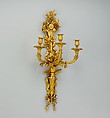Set of four three-light wall brackets
Functional and exceedingly decorative bronzes d’ameublement, the so-called furnishing bronzes – wall lights, candelabra, and other types of lighting, firedogs, hearth furnishings, and clocks – were an important aspect of the eighteenth-century décor. Well-known artists and sculptors designed them closely following the latest styles. An elaborate guild system regulated the process of their creation and maintained high standards of craftsmanship. Consisting of many different steps, the manufacture of gilt-bronze objects was principally in the hands of the bronze workers, who were divided in eighteenth-century France in two guilds: that of the fondeurs-ciseleurs, or casters and chasers, and that of the ciseleurs-doreurs, or chasers and gilders.
These wall lights, consisting of a set of six [see also 2019.283.76, .77], are made of chased and gilded bronze and epitomize the neo-classical style prevalent at the time. The back plate of each wall light is surmounted by a ribbon from which the bracket seems to be suspended, tied in a bow knot around a large nail at the top. Two laurel sprays are entwined around this ribbon, their ends tied in another bow knot at the lower end of the stem. Three curved candle branches spring from an acanthus leaf spray also fitted with a bouquet of flowers. The branches terminate in candleholders in the shape of leaf cups The circular tapered lower part stem takes the form of a fluted torch.
Even though it is not known who created these wall lights, they are beautifully chased. The matte and burnished areas would have lent the wall lights great vitality through the various ways that the flickering candle light would be reflected differently off the differently finished surfaces.
This image cannot be enlarged, viewed at full screen, or downloaded.
This artwork is meant to be viewed from right to left. Scroll left to view more.



